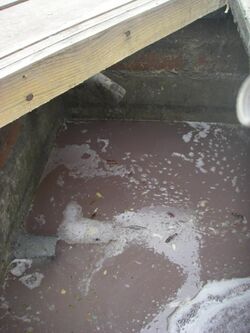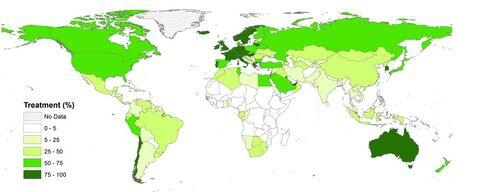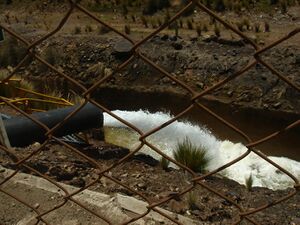Earth:Wastewater

Wastewater is any water that has been contaminated by human use. Wastewater is "used water from any combination of domestic, industrial, commercial or agricultural activities, surface runoff or stormwater, and any sewer inflow or sewer infiltration".[1] Therefore, wastewater is a byproduct of domestic, industrial, commercial or agricultural activities. The characteristics of wastewater vary depending on the source. Types of wastewater include: domestic wastewater from households, municipal wastewater from communities (also called sewage) and industrial wastewater. Wastewater can contain physical, chemical and biological pollutants.
Households may produce wastewater from flush toilets, sinks, dishwashers, washing machines, bath tubs, and showers. Households that use dry toilets produce less wastewater than those that use flush toilets.
Wastewater may be conveyed in a sanitary sewer that conveys only sewage. Alternatively, wastewater can be transported in a combined sewer that conveys both stormwater runoff and sewage, and possibly also industrial wastewater. After treatment at a wastewater treatment plant, treated wastewater (also called effluent) is discharged to a receiving water body. The terms "wastewater reuse" and "water reclamation" apply if the treated waste is used for another purpose. Wastewater that is discharged to the environment without suitable treatment can cause water pollution.
In developing countries and in rural areas with low population densities, wastewater is often treated by various on-site sanitation systems and not conveyed in sewers. These systems include septic tanks connected to drain fields, on-site sewage systems (OSS), vermifilter systems and many more.
Sources
Sources of wastewater include the following domestic or household activities:
- Human excreta (feces, urine, blood and other bodily fluids) often mixed with used toilet paper or wet wipes; this is known as blackwater if it is collected from flush toilets
- Washing water (personal hygiene, clothes, floors, dishes, cars, etc.), also known as greywater or sullage
- Surplus manufactured liquids from domestic sources (drinks, cooking oil, pesticides, lubricating oil, paint, cleaning detergents, etc.)
Activities producing industrial wastewater include:
- Industrial site drainage (silt, sand, alkali, oil, chemical residues);
- Industrial cooling waters (biocides, heat, slimes, silt)
- Industrial processing waters
- Organic or biodegradable waste including waste from hospitals, abattoirs, creameries, and food factories.
- Organic or non bio-degradable waste that is difficult-to-treat from pharmaceutical [2] or pesticide manufacturing
- Extreme pH waste from acid and alkali manufacturing
- Toxic waste from metal plating, cyanide production, pesticide manufacturing, etc.
- Solids and emulsions from paper mills, factories producing lubricants or hydraulic oils, foodstuffs, etc.
- Water used in hydraulic fracturing
- Produced water from oil & natural gas production
Other related activities or events:
- Urban runoff from highways, roads, railway tracks, car parks, roofs, pavements (contains oils, animal feces/manure, food waste, litter, petrol, diesel or rubber residues from tyres, soapscum, metals from vehicle exhausts, de-icing agents, herbicides and pesticides from gardens, etc.)
- Agricultural pollution, direct and diffuse
Wastewater can be diluted or mixed with other types of water through the following mechanisms:
- Seawater ingress (high volumes of salt and microbes)
- Direct ingress of river water
- Rainfall collected on roofs, yards, hard-standings, etc. (generally clean with traces of oils and fuel)
- Groundwater infiltrated into sewage
- Mixing with other types of wastewater or fecal sludge
Pollutants
The composition of wastewater varies widely. This is a partial list of pollutants that may be contained in wastewater:
Chemical or physical pollutants
- Heavy metals, including mercury, lead, and chromium
- Organic particles such as feces, hairs, food waste, vomit, paper fibers, plant material, humus, etc.;
- Soluble organic material such as urea, fruit sugars, soluble proteins, drugs, pharmaceuticals, etc.;
- Inorganic particles such as sand, grit, metal particles, rubber residues from tires, ceramics, etc.;
- Soluble inorganic material such as ammonia, road-salt, sea-salt, cyanide, hydrogen sulfide, thiocyanates, thiosulfates, etc.;
- Macro-solids such as sanitary napkins, nappies/diapers, condoms, needles, children's toys, dead animals or plants, etc.;
- Gases such as hydrogen sulfide, carbon dioxide, methane, etc.;
- Emulsions such as paints, adhesives, mayonnaise, hair colorants, emulsified oils, etc.;
- Toxins such as pesticides, poisons, herbicides, etc.
- Pharmaceuticals, endocrine disrupting compounds, hormones, perfluorinated compounds, siloxanes, drugs of abuse and other hazardous substances [3][4][5]
- Microplastics such as polyethylene and polypropylene beads, polyester and polyamide [6]
- Thermal pollution from power stations and industrial manufacturers
Biological pollutants
If the wastewater contains human feces, as is the case for sewage, then it may also contain pathogens of one of the four types:[7][8]
- Bacteria (for example Salmonella, Shigella, Campylobacter, Vibrio cholerae),
- Viruses (for example hepatitis A, rotavirus, enteroviruses, coronaviruses),
- Protozoa (for example Entamoeba histolytica, Giardia lamblia, Cryptosporidium parvum) and
- Parasites such as helminths and their eggs (e.g. Ascaris (roundworm), Ancylostoma (hookworm) and Trichuris (whipworm));
It can also contain non-pathogenic bacteria and animals such as insects, arthropods and small fish.
Quality indicators
Since all natural waterways contain bacteria and nutrients, almost any waste compounds introduced into such waterways will initiate biochemical reactions such as detailed above. Those biochemical reactions create what is measured in the laboratory as the biochemical oxygen demand (BOD). Such chemicals are also liable to be broken down using strong oxidizing agents and these chemical reactions create what is measured in the laboratory as the chemical oxygen demand (COD). Both the BOD and COD tests are a measure of the relative oxygen-depletion effect of a waste contaminant. Both have been widely adopted as a measure of pollution effect. The BOD test measures the oxygen demand of biodegradable pollutants whereas the COD test measures the oxygen demand of oxidizable pollutants.
Any oxidizable material present in an aerobic natural waterway or in an industrial wastewater will be oxidized both by biochemical (bacterial) or chemical processes. The result is that the oxygen content of the water will be decreased.
Aquatic toxicology tests are used to provide qualitative and quantitative data on adverse effects on aquatic organisms from a toxicant. Testing types include acute (short-term exposure), chronic (life span) and bioaccumulation tests.[9] Many industrial facilities in the US conduct "whole effluent toxicity" tests on their wastewater discharges, typically in combination with chemical tests for selected pollutants.[10]
Management
Collection
Wastewater from factories, power plants and other industrial activities is extensively regulated in developed nations, and treatment is required before discharge to surface waters. (See Industrial wastewater treatment.)
In many cities, municipal wastewater is carried together with stormwater, in a combined sewer system, to a sewage treatment plant. In some urban areas, municipal wastewater is carried separately in sanitary sewers and runoff from streets is carried in storm drains. Access to these systems, for maintenance purposes, is typically through a manhole.
During high precipitation periods a combined sewer system may experience a combined sewer overflow event, which forces untreated sewage to flow directly to receiving waters. This can pose a serious threat to public health and the surrounding environment.
In less-developed or rural regions, sewage may drain directly into major watersheds with minimal or no treatment. This usually has serious impacts on the quality of an environment and on human health. Pathogens can cause a variety of illnesses. Some chemicals pose risks even at very low concentrations and can remain a threat for long periods of time because of bioaccumulation in animal or human tissue.
Treatment and disposal

At the global level, an estimated 52% of wastewater is treated.[11] However, substantial differences in wastewater collection and treatment rates vary by level of economic development, with high-income, upper-middle, lower-middle and low income countries treating approximately 74%, 43%, 26% and 4.2% of their wastewater, respectively.[11] Wastewater that is discharged into the environment without undergoing treatment threatens widespread water pollution.[12]
There are numerous processes that can be used to clean up wastewaters depending on the type and extent of contamination. Wastewater can be treated in wastewater treatment plants which include physical, chemical and biological treatment processes. Municipal wastewater is treated in sewage treatment plants (which may also be referred to as wastewater treatment plants). Agricultural wastewater may be treated in agricultural wastewater treatment processes, whereas industrial wastewater is treated in industrial wastewater treatment processes.
For municipal wastewater the use of septic tanks and other On-Site Sewage Facilities (OSSF) is widespread in some rural areas, for example serving up to 20 percent of the homes in the U.S.[13]
One type of aerobic treatment system is the activated sludge process, based on the maintenance and recirculation of a complex biomass composed of micro-organisms able to absorb and adsorb the organic matter carried in the wastewater. Anaerobic wastewater treatment processes (UASB, EGSB) are also widely applied in the treatment of industrial wastewaters and biological sludge. Some wastewater may be highly treated and reused as reclaimed water. Constructed wetlands are also being used.
Some facilities such as oil and gas wells may be permitted to pump their wastewater underground through injection wells. Wastewater injection has been linked to induced seismicity.[14]
Reuse
Global treated wastewater reuse is estimated at 40.7 billion m3 per year, representing approximately 11% of the total domestic and manufacturing wastewater produced.[11] Wastewater reuse is particularly high in the Middle East and North Africa region, in countries such as the UAE, Qatar, Kuwait and Israel.
Treated wastewater can be reused in industry (for example in cooling towers), in artificial recharge of aquifers, in agriculture and in the rehabilitation of natural ecosystems (for example in wetlands). In rarer cases it is also used to augment drinking water supplies. There are several technologies used to treat wastewater for reuse. A combination of these technologies can meet strict treatment standards and make sure that the processed water is hygienically safe, meaning free from bacteria and viruses. The following are some of the typical technologies: Ozonation, ultrafiltration, aerobic treatment (membrane bioreactor), forward osmosis, reverse osmosis, advanced oxidation.
Some water demanding activities do not require high grade water. In this case, wastewater can be reused with little or no treatment. One example of this scenario is in the domestic environment where toilets can be flushed using greywater from baths and showers with little or no treatment.
Irrigation with recycled wastewater can also serve to fertilize plants if it contains nutrients, such as nitrogen, phosphorus and potassium. In developing countries, agriculture is using untreated wastewater for irrigation - often in an unsafe manner. There can be significant health hazards related to using untreated wastewater in agriculture. The World Health Organization developed guidelines for safe use of wastewater in 2006.[15]
Legislation
Terminology
The broad term sanitation includes the management of wastewater, human excreta, solid waste and stormwater. The term sewerage refers to the physical infrastructure required to transport and treat a certain type of wastewater, namely sewage.
See also
- Fecal sludge management
- List of waste-water treatment technologies
- Sanitation
- Wastewater-based epidemiology
- Waste management
- Water management
- Water pollution
References
- ↑ Tilley, E., Ulrich, L., Lüthi, C., Reymond, Ph., Zurbrügg, C. (2014). Compendium of Sanitation Systems and Technologies – (2nd Revised ed.). Swiss Federal Institute of Aquatic Science and Technology (Eawag), Duebendorf, Switzerland. p. 175. ISBN 978-3-906484-57-0. http://www.eawag.ch/en/department/sandec/publications/compendium/.
- ↑ Naddeo, V.; Meriç, S.; Kassinos, D.; Belgiorno, V.; Guida, M. (September 2009). "Fate of pharmaceuticals in contaminated urban wastewater effluent under ultrasonic irradiation" (in en). Water Research 43 (16): 4019–4027. doi:10.1016/j.watres.2009.05.027. PMID 19589554.
- ↑ Arvaniti and Stasinakis, 2015. Review on the occurrence, fate and removal of perfluorinated compounds during wastewater treatment. Science of the Total Environment vol. 524-525, August 2015, p. 81-92. Arvaniti and Stasinakis, 2015
- ↑ Bletsou et al., 2013. Mass loading and fate of linear and cyclic siloxanes in a wastewater treatment plant in Greece. Environmental Science and Technology vol. 47, January 2015, p. 1824-1832. Bletsou et al., 2013
- ↑ Gatidou et al., 2016. Drugs of abuse and alcohol consumption among different groups of population on the Greek island of Lesvos through sewage-based epidemiology. Science of the Total Environment vol. 563-564, September 2016, p. 633-640. Gatidou et al., 2016
- ↑ Gatidou et al. 2019. Review on the occurrence and fate of microplastics in Sewage Treatment Plants. Journal of Hazardous Materials, vol. 367, April 2019, p. 504-512. Gatidou et al., 2019
- ↑ World Health Organization (2006). Guidelines for the safe use of wastewater, excreta, and greywater.. World Health Organization. pp. 31. ISBN 978-9241546850. OCLC 71253096.
- ↑ Andersson, K., Rosemarin, A., Lamizana, B., Kvarnström, E., McConville, J., Seidu, R., Dickin, S. and Trimmer, C. (2016). Sanitation, Wastewater Management and Sustainability: from Waste Disposal to Resource Recovery . Nairobi and Stockholm: United Nations Environment Programme and Stockholm Environment Institute. ISBN:978-92-807-3488-1, p. 56
- ↑ Rand, Gary M., ed (1995). Fundamentals of Aquatic Toxicology (2nd ed.). London: Taylor & Francis. ISBN 1-56032-091-5.
- ↑ "Whole Effluent Toxicity (WET)". Washington, D.C.: U.S. Environmental Protection Agency (EPA). 2019-09-17. https://www.epa.gov/npdes/whole-effluent-toxicity-wet.
- ↑ 11.0 11.1 11.2 11.3 Jones, Edward R.; van Vliet, Michelle T. H.; Qadir, Manzoor; Bierkens, Marc F. P. (2021-02-08). "Country-level and gridded estimates of wastewater production, collection, treatment and reuse" (in English). Earth System Science Data 13 (2): 237–254. doi:10.5194/essd-13-237-2021. ISSN 1866-3508. https://essd.copernicus.org/articles/13/237/2021/.
- ↑ WWAP (United Nations World Water Assessment Programme) (2017). The United Nations World Water Development Report 2017. Wastewater: The Untapped Resource. Paris. ISBN 978-92-3-100201-4. http://www.unwater.org/publications/publications-detail/en/c/853650/.
- ↑ U.S. Environmental Protection Agency, Washington, D.C. (2008). "Septic Systems Fact Sheet." EPA publication no. 832-F-08-057.
- ↑ van der Baan, Mirko; Calixto, Frank J. (2017-07-01). "Human-induced seismicity and large-scale hydrocarbon production in the USA and Canada". Geochemistry, Geophysics, Geosystems 18 (7): 2467–2485. doi:10.1002/2017gc006915. ISSN 1525-2027. Bibcode: 2017GGG....18.2467V.
- ↑ WHO (2006). WHO Guidelines for the Safe Use of Wastewater, Excreta and Greywater – Volume IV: Excreta and greywater use in agriculture . World Health Organization (WHO), Geneva, Switzerland



